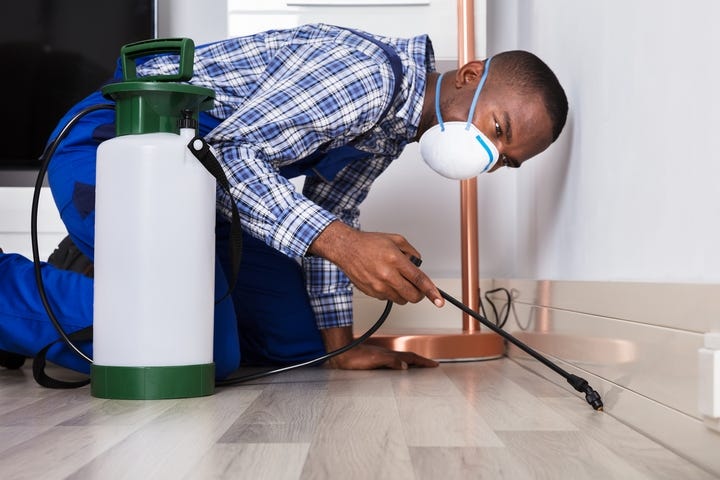Dependable Pest Control Washington DC: Secure Your Home and Business!
Wiki Article
Specialist Insect Control Techniques for Long-Term Outcomes
Professional pest control techniques encapsulate a detailed technique that starts with a comprehensive evaluation and evaluation, adhered to by specific parasite recognition to comprehend their habits patterns. The application of Integrated Bug Monitoring (IPM) concepts, paired with eco-conscious therapies, develops the foundation of lasting pest eradication.Inspection and Assessment
Upon entering a residential or commercial property for pest control services, the initial step is an extensive examination and assessment to recognize the extent of the infestation and determine the most effective treatment plan. Expert bug control service technicians are trained to meticulously analyze the facilities, trying to find signs of parasite activity such as droppings, munch marks, nests, or any structural damages. They will additionally analyze the problems that might be drawing in insects, such as food sources, water leaks, or entry factors.
Insect Recognition and Actions

Moreover, comprehending the behavior of the identified parasite is vital to applying efficient control steps. For example, knowing where pests nest, what they feed on, and their task patterns can assist pest control professionals devise approaches to eliminate them efficiently. Some insects may be nighttime, while others are much more energetic throughout the day. This knowledge enables the application of treatments at optimal times for optimum effectiveness.
Integrated Parasite Administration (IPM)
Integrated Parasite Administration (IPM) methods combine several strategies to control and protect against pest invasions in a lasting and ecologically pleasant way. exterminator. By integrating approaches such as organic control, habitat control, adjustment of social practices, and using resistant ranges, IPM intends to decrease making use of chemical pesticidesOne of the crucial concepts of IPM is the focus on prevention. This aggressive approach includes tracking parasite populaces routinely to find any kind of possible issues prior to they intensify. By recognizing pest problems at an early stage, pest control procedures can be applied promptly and effectively.
Furthermore, IPM advertises the use of non-toxic insect control techniques whenever possible. This can include employing natural predators of the pests, introducing helpful pests, or utilizing scents to interrupt breeding patterns. By reducing dependence on chemical pesticides, IPM not only safeguards the setting but additionally helps keep a balance in the ecological community.
Environmentally-Friendly Therapies
Executing eco-conscious techniques in bug control anderson pest control procedures can efficiently address infestations while prioritizing ecological sustainability. Environmentally-friendly therapies focus on reducing the impact of parasite control approaches on environments, non-target organisms, and human health. These methods usually entail using natural killers, such as ladybugs or nematodes, to manage pest populations, reducing the requirement for chemical treatments. In addition, methods like environment control, such as adjusting dampness degrees or removing food resources, can help deter parasites without making use of damaging substances.One more key element of environmentally-friendly therapies is the use of natural and biodegradable items that damage down rapidly without Extra resources leaving harmful deposits in the setting. Organic insecticides originated from plants like chrysanthemums or neem supply effective bug control while posing very little risk to non-target species. Moreover, using methods like warm therapies or scent traps can target certain parasites with precision, decreasing the total environmental effect of bug control techniques.
Ongoing Tracking and Upkeep
Routine inspections by experienced specialists are required to identify any kind of indications of pest task, examine the effectiveness of previous therapies, and make modifications to the pest control strategy as needed. By checking bug populations over time, insect control experts can track fads, expect possible problems, and apply precautionary measures to lessen the risk of future infestations.
In addition to surveillance, upkeep practices are important for long-lasting parasite control success. This you can try here includes executing appropriate hygiene measures to eliminate prospective food and water sources for bugs, securing off access points to avoid insects from going into the facilities, and resolving any kind of architectural issues that could help with insect invasions (bed bug treatment). By integrating continuous tracking and maintenance into an integrated pest management strategy, businesses can guarantee a pest-free environment and protect their home versus expensive damage and health risks
Verdict
To conclude, making use of specialist bug control methods such as thorough assessment and evaluation, accurate pest recognition and understanding of their habits, integrated pest monitoring strategies, environmentally-friendly treatments, and ongoing monitoring and upkeep are vital for accomplishing long-term lead to bug control. By executing these approaches, people can efficiently manage parasite invasions and maintain a pest-free setting in a sustainable fashion.Report this wiki page